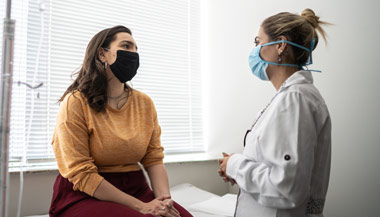Patient Story
Endoscopic Sleeve Gastroplasty for Weight Loss: Vivienne’s Story

Patient Story Highlights
- Losing weight had been a lifetime struggle for Vivienne, a busy physician and researcher from the Netherlands.
- Vivienne consulted with a gastroenterologist about the endoscopic sleeve gastroplasty program.
- Vivienne found the motivation to meet her 60-pound weight loss goal in five months.
In 2016, Vivienne van de Walle found herself at a crossroads. She was fed up with her lifelong struggle to lose weight. The 49-year-old physician and clinical researcher from the Netherlands was desperate to find a solution, but she was about ready to quit looking.
Vivienne’s body mass index (BMI), which measures body fat based on height and weight, was 44. People with a BMI over 25 are at greater risk of developing serious health problems. Despite her high BMI, Vivienne had a strong, healthy heart along with normal cholesterol, blood sugar and blood pressure levels. So when her primary physician asked if she’d consider weight loss surgery, she said she’d rather accept that she couldn’t lose weight than have surgery.
“I didn’t have a medical need, like diabetes or high blood pressure,” says Vivienne. “For me, surgery was a line I wasn’t willing to cross. I didn’t believe in operating on a healthy body, knowing the risks involved. I had to lose the weight on my own,” she explained.
And over the years she’d tried to trim down, with only short-term success at best.
“I’ve been to a dietitian, joined weight loss groups, tried different diets, taken prescription weight loss medication — everything out there, I’ve tried it,” Vivienne says. “Usually the weight loss was so slow that I lost motivation, or gained it all back, like when I quit taking the weight loss medication. My metabolism is just not as fast as others’.”
Finding a New Option Far From Home
She found a glimmer of hope while traveling for work and reading a scientific paper during a flight to the United States. It described endoscopic sleeve gastroplasty (ESG), a new, minimally invasive weight loss procedure. The procedure uses a suturing device attached to an endoscope — a thin, flexible tube with a tiny camera and light — to reduce the size of the stomach by 70%. The smaller, tube-shaped stomach restricts the amount of food patients can eat and the number of calories their bodies can absorb.
The gastroenterologist inserts the endoscope down the throat into the stomach. The camera on the endoscope allows the surgeon to see and perform the procedure without making an incision in the abdomen. The procedure takes about 90 minutes, and most patients go home the same day.
“I turned to my colleague who was traveling with me and said, ‘Look at this: You literally go in and out the same day,’” recalls Vivienne.
It wasn’t until a few months later that her frustration about her weight led her to search online for more information about ESG. She landed on the Johns Hopkins website, where she learned that ESG was among the minimally invasive weight loss procedures offered by the program.
She emailed and then talked by phone with a clinical registered nurse and the program coordinator, to learn more about the procedure and Johns Hopkins’ comprehensive program. The program goes beyond the procedure and includes a year of support and coaching from a team of weight loss experts. The program coordinator emails and talks with patients by phone twice a month. A medical internist, nutritionist, exercise physiologist and a behavioral psychologist help patients make lifestyle changes to lose weight and keep it off.
ESG is safe and effective, and also has a short, three-day recovery. It's currently the most effective endoscopic method for weight loss, and it's suitable for almost everyone.
Vivienne scheduled a consultation with the Johns Hopkins Endoscopic Weight Loss Program right away. Most consultations with out-of-town patients are done by phone for the patients’ convenience. But Vivienne wanted to meet her team face-to-face. It paid off. She left the in-person consult feeling confident that the procedure and the team would help her make the lifestyle changes needed to lose the weight for good.
“In Europe, we socialize with nice dinners where you sit down at 7 p.m. and don’t leave the table until 11 p.m. I couldn’t imagine not being able to do that,” says Vivienne.
Vivienne's provider assured her those dinners weren’t off the table. She’d be able to eat whatever foods she wanted — even have a glass of wine — just in smaller portions.
“I knew the procedure was what I wanted to do,” says Vivienne. “I saw it as a tool to help me lose weight, not the total solution.”
Vivienne was an excellent candidate for the procedure. As a very busy physician who does lots of traveling and can’t afford the downtime for recovery that’s required with surgery, Vivienne appreciated ESG’s a short, three-day recovery.
Time for Changes
On May 22, 2017, Vivienne had the 75-minute procedure. By 2:00 that afternoon she was napping in her hotel room. Four days later, she was on a flight home and was able to return to work the next day.
“After the procedure, I felt like my doctor said I would — there was pain in my stomach area, and I felt a bit nauseated, but it was bearable,” recalls Vivienne.
She consumed only liquids until she got home to the Netherlands. Since then, she’s eaten whatever she wants — in much smaller portions — focusing on a diet of fish, chicken, dairy, vegetables and fruit. But Vivienne says she never feels deprived.

“I’m a human being — I have a glass of wine, I eat a cupcake, just not all the time,” she says.
Eating healthy foods in smaller portions, combined with exercise, helped Vivienne hit her 60-pound weight loss goal in just five months. Her BMI dropped by 10 points, too. Her new goal is to lose 30 more pounds.
“I think my metabolism has changed, too,” says Vivienne. “Before, I never lost a lot of weight in a short time. Getting such a good result so quickly keeps me motivated to continue.”
The program coordinator kept in regular contact with Vivienne and helped her learn a key to success: eat until the first sign of fullness and then stop.
ESG is a tool that helps you eat smaller portions, so the minute patients are full, they don’t eat anymore because they are satisfied. Eating too much can cause discomfort.
Vivienne also chose to include additional visits at the Johns Hopkins Weight Management Center as part of her program. The center’s weight loss experts include a physician, behavioral therapist, nutritionist and exercise physiologist who work one-on-one with Vivienne to give her the support she needs.
Vivienne works out twice a week with a trainer, using electrical muscle stimulation. A machine delivers electrical pulses that stimulate heightened muscle contractions and intensify a workout.
“It’s a comprehensive program, but it’s individualized, not a one-size-fits-all approach,” says Vivienne.
Her frequent travel to the United States and the team’s willingness to accommodate her schedule has made it easy to plan her visits to the Weight Management Center.
“We also use the benefits of the technology that’s out there, too, like email, Skype and phone calls,” says Vivienne. “We all agreed that distance shouldn’t be an issue and we’ve proven that it isn’t.”
At the airport for a recent trip, the reality of how much weight she’d lost hit Vivienne.

“Carrying my heavy suitcase I thought, ‘Four months ago, I had even more weight than this on my body.’ I don’t know how I was able to do that for all of those years.”
She says the ESG program allows her to focus on new things she’s able to do.
“I fold my hands and feel the bones of my fingers because they’re less chubby. I go out to dinner at nice restaurants and don’t have to ask for them to make me something special,” says Vivienne. I’ve focused on being grateful for what I can do.”
It’s why she doesn’t keep her weight loss strategy a secret.
“I proudly tell people that I went to Johns Hopkins for a procedure that’s not available in Europe and that it was one of the best decisions of my life.”
Johns Hopkins Endoscopic Weight Loss Program
The team with the Endoscopic Weight Loss Program offers innovative weight loss procedures that do not require invasive surgery. We take a collaborative approach to obesity management that combines the expertise of many specialists, which helps us offer high-quality care and enable long-term weight loss.




